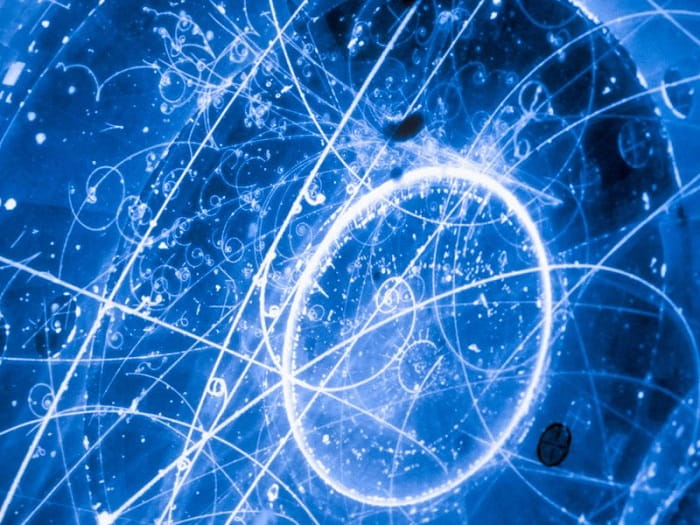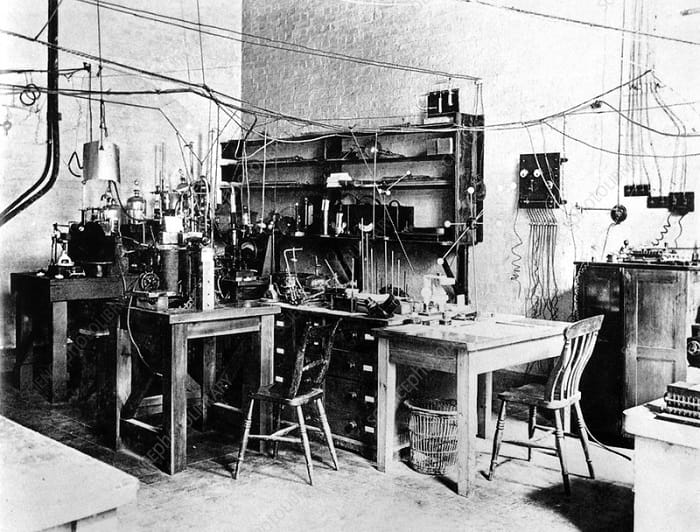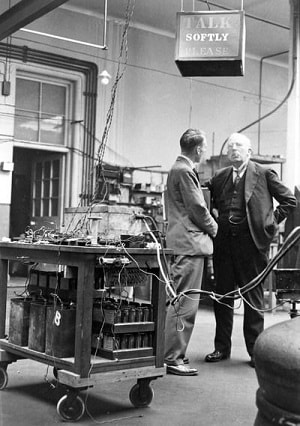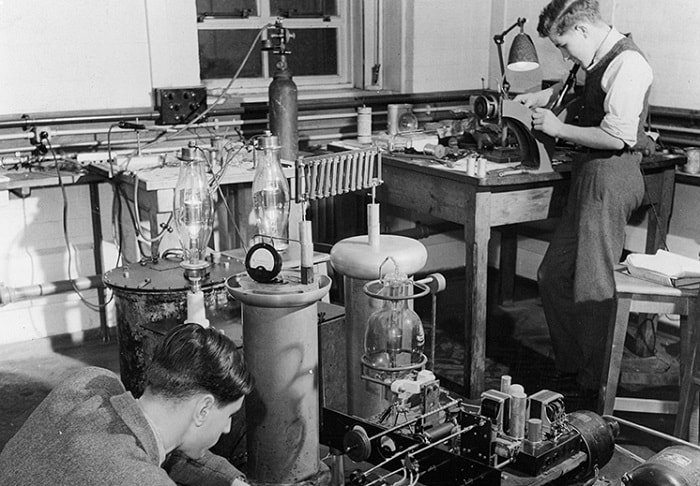Ernest Rutherford was the father of nuclear physics. Although he was best known for his discovery of the atomic nucleus—which is the basis of much of modern physics—he received the Nobel Prize in chemistry for his investigations into the disintegration of the elements. High-energy particle physics, which investigates the nature of matter and its origins in the Big Bang, and modern nuclear technology—from nuclear power plants and weapons to nuclear medicine—are just a few examples of his legacy. The depth and width of Rutherford’s discoveries in experimental physics are equal to Einstein‘s discoveries in theoretical physics.
- Who is Ernest Rutherford?
- Radioactivity was perceived as alchemy
- The discovery of the disintegration of elements
- Ernest Rutherford and the discovery of the atomic nucleus
- He inspired the atomic model and theory
- Ernest Rutherford and the split of an atom
- How did Ernest Rutherford discover the proton?
- The discovery of the neutron
- The discovery of the artificial transmutation of elements
- Nuclear physics studies with Ernest Rutherford
- Ernest Rutherford quotes
Who is Ernest Rutherford?
Born in New Zealand, Ernest Rutherford arrived in England almost unintentionally in 1895. The person who won New Zealand’s international scholarship that year was not able to use it for marriage reasons. Rutherford was the second person in line. Nonetheless, his future could be very different when he arrives in Cambridge. His research in New Zealand was on electrical technology, and for a short time, he held the world record for the distance that electromagnetic waves could be detected.

At that time, he was ahead of Guglielmo Marconi and planned to continue his work in this field, but that same year, in 1895, Wilhelm Röntgen discovered X-rays. It was soon followed by Henri Becquerel’s discovery of radioactivity. Under the leadership of J. J. Thomson in Cambridge, the focus of research shifted to this new mysterious radiation. It is said that Thomson consulted Lord Kelvin, and he replied that there was no future for radio; Rutherford was then directed to radioactivity.
Becquerel discovered radioactivity in 1896, and the Curries named it in 1899, during the radio discovery process; however, it was Rutherford who turned this discovery into a scientific tool. He used radiation to bombard the atoms and sample their internal structure. In the 1890s, while doing his doctoral studies at the Cavendish Laboratory in Cambridge, he worked as a professor at McGill University in Canada and uncovered the secrets of the structure of an atom with his studies conducted in Manchester. In 1919, he returned to Cambridge as the greatest experimental physicist of his time to replace his mentor, Thomson.
Radioactivity was perceived as alchemy

Ernest Rutherford first worked with Thomson on the ionizing effects of X-rays in gases. After that, he began to work on his first major contribution, which was to measure how much radiation uranium gives off. To do this, he wrapped the uranium sample in aluminum foil. Radiation was absorbed during this process. He found that, as expected, as its thickness went up, the radiation intensity went down, meaning that the radiation was taken in at a faster rate. However, he saw that the density did not change when the thickness increased even more. Still, after adding a few more layers of aluminum, he was able to finally say that the density had dropped.
The densities were decreasing at much lower rates than before. From there, he concluded that there should be two types of radiation. The one was quickly absorbed, and he called it alpha; the latter, which he called beta, penetrated the foil. Then he found an emission called gamma that was penetrating more.
In 1898, he moved to McGill University in Montreal, Canada. The first thing he did here was to measure the amount of energy emitted by uranium. Right there, he would experience a great moment of realization: the amount of energy observed was 100 times larger than produced by any known chemical reaction. With these measurements, he noticed the first sign of hidden power in the depths of the atom.
The discovery of the disintegration of elements
Thomson showed in 1897 that atoms contain small electrical particles called electrons. To balance the negative charges, there must also be a positive charge inside the atom; this indicates the complex structure of the atom. Rutherford argued in 1900 that the power of uranium was due to the rearrangement of its atomic content. While the structure of the atom is still waiting to be explained, this was a remarkable theory for its time, especially since other scientists, like the Curies, at least had the opinion that radioactive energy originated from the outside of the atom.
During this period, Ernest Rutherford began to deal with the unusual behavior of the radioactivity of the thorium element. The amount of radioactivity seemed variable and sensitive to the breeze in the air. After a series of experiments, he decided that thorium releases some kind of radioactive gas. The gas was affected by the flow in the air. He needed the help of a chemist to determine the content of this gas: Frederick Soddy. They found, no doubt, that this was a new element—radon. With this discovery, they found the first evidence that one element—thorium—could transform into another element—radon.
When Soddy yelled, “Rutherford, this is transmutation,” Rutherford replied: “For Mike’s sake Soddy, don’t call it transmutation. They’ll have our heads off as alchemists.” But that’s exactly what they accomplished; it was really alchemy, but it occurred naturally. Thus, they first showed that thorium was turned into radium. Then, radium was turned into radon, and radiation was emitted at every stage. In addition to drawing attention to the array of values of the elements in the periodic table, they also showed that radiation is formed by such a transformation.
Ernest Rutherford and the discovery of the atomic nucleus

Rutherford moved from McGill University to Manchester in 1907. He used the prototype of the counter with the young German Hans Geiger, now known as the Geiger counter, and showed that the nucleus is made up of particles that are positively charged and have 10,000 times the mass of the electron. Even the nuclei were twice as charged as the helium atom. Rutherford collected a large number of alpha particles in 1908, neutralized these particles with electrons, and examined the spectrum of the resulting gas. It proved that alpha particles are equivalent to a helium nucleus.
That year, he announced this discovery in his Nobel Prize speech on his collaborative work with Soddy for the disintegration—he received the award in chemistry, not in physics. Rutherford had always seen physics far ahead of chemistry, even likening chemistry to stamp collecting. However, he also knew how to make jokes about his rapid transformation from the field of physics to chemistry.
It was true that he received this award in chemistry. Rutherford and Soddy used physical methods, but the field they made a revolution in was chemistry. During the Nobel Prize ceremony, Lady Rutherford was told that her husband would also receive the physics award one day. But he never received it, which was surprising as his lifetime series of discoveries had just begun.
The discovery of alpha particles provided definitive evidence that heavy atoms can decay into lighter atoms by emitting small atomic particles. This begged the question of how negatively charged, lightweight electrons and positively charged conjugates are organized within the atom. The answer to this fundamental question lay in Rutherford’s next discovery.
Ernest Rutherford and Hans Geiger made a zinc sulfide-coated screen, which allowed electric particles such as alpha particles to scatter slightly when struck. When he worked at McGill, he noticed that alpha particles seemed to diverge from the flight lines as they passed through the thin mica leaf. This was surprising as the alpha particles were moving at a speed of 21% of the speed of light, that is, 9,300 miles (15,000 kilometers) per second. The deviation of alpha particles implied a much greater presence than any known electrical and magnetic force. From that, he came up with the idea that this powerful force exists within the atom.
He inspired the atomic model and theory
Geiger had a young student named Ernest Marsden. Rutherford suggested to Marsden in 1909 that he see if any alpha particles deviated at very large angles. Instead of mica, Marsden used a gold leaf and a glowing screen to detect the scattered alpha particles. Everyone was amazed when Marsden announced that every one of the twenty thousand alpha particles bounced back in the exact direction they had come from. This happened only when they hit a very thin gold leaf that is a few hundred atoms thick. Rutherford yelled and made that well-known quote: “If you fired a 15-inch shell at a piece of tissue paper and it came back and hit you.”
For a year, he worked on this phenomenon, eventually discovering that the positive charge in the atom was concentrated around the excessively dense mass of the central nucleus. What bounced back the alpha particles, which are relatively lightweight compared to the nucleus of the gold atom, which is about fifty times heavier, were the same charges repelling each other. The size of the nucleus relative to the atom, with the famous quote, was “a fly in the cathedral.“
Rutherford discovered the atomic nucleus and paved the way for his assistant in Manchester, Niels Bohr, to invent the atomic model in 1913. This discovery, which has gained wide popularity with the introduction of the ideas of quantum theory that is in its infancy, has led to the revival of the image of a miniature “solar system” in which “planet-like” lightweight electrons revolve around the “sun-like” heavy nucleus. Although these details were later developed with mature ideas of quantum mechanics and relativity, this simple picture was able to survive for a century.
Ernest Rutherford and the split of an atom

These experiments proved the existence of the atomic nucleus but did not examine the structure of the nucleus. In an electrically charged neutral atom, the positive electric charge of the nucleus is balanced by the negative electric charge of the surrounding electrons. Rutherford discovered that if lighter elements have fewer electrons than heavier atoms, the charge in their nuclei should also be smaller. With this in mind, the resistance to alpha particles should be less, and the alphas should be able to approach closer.
Hydrogen is the lightest element, so Rutherford and Marsden started sending alpha particles to hydrogen. Alphas are produced by a radioactive source, pass through hydrogen gas, and are detected by luminescence when zinc sulfide hits the screen. If the screen was farther than a certain distance, the glow would go off. Because the alphas lost energy by colliding with many air molecules between hydrogen and the screen, they were about the same distance from the radioactive source that produced them.
How did Ernest Rutherford discover the proton?
Rutherford used a magnetic field and proved that this phenomenon was caused by positively charged particles that are lighter than alpha particles. He noticed that these lighter positive particles were dislodged from the hydrogen atoms by the impact of the energetic alpha particles. He called this positively charged nucleus of the hydrogen atom “H-particles,” and today we call them protons.
This was a far-reaching discovery, but it was not enough to justify the idea that protons are positively charged particles located in the atomic nuclei of all elements. That significant development would happen after Rutherford thought over an anomaly for three years that was found by Marsden: H-particles were also produced when alpha particles passed through the air.
Marsden discovered this in 1914. Later he set out to go to New Zealand, and many other students also participated in the First World War. Rutherford patiently researched this phenomenon alone and eventually determined what was going on. He sent alpha particles to different lightweight elements and found clues about the H-particles. He noticed that the H-particles emanate from the atoms of these elements; In Marsden’s original experiment, they were originating from nitrogen, an important component of the atmosphere. With this new finding, Rutherford determined that the H-particles are the fundamental particles of the nuclei of all atoms, and in 1919 he called these particles protons.
The discovery of the neutron
There is a story that shows the magnitude of this discovery. During the war, Rutherford’s expertise was sought, and he invented methods to detect submarines. At the turning point of his experiments on the proton, he asked the government’s scientific committee for permission, saying that if what he thinks is true, it will be more important than winning the war. Considering what happened after Rutherford discovered the atomic nucleus and considering his role in the atomic bomb that ended the Second World War, he was very forward-thinking.

By the 1920s, the role of the proton in determining the charge of the nucleus was determined, but it was still insufficient to explain the relative weight of the nuclei of different elements. The alpha particle, which had twice the charge of the proton, was still four times heavier than it. Therefore, in 1920, Rutherford proposed the existence of a neutron, that is, a particle similar to that of a proton but with no electric charge. Thus, the reason an alpha particle was four times heavier than a proton was that it contained two protons and two neutrons. Rutherford was now appointed as a Cavendish professor in place of Thomson and moved to Cambridge.
Here, under the direction of Rutherford, James Chadwick discovered the neutron in 1932.
Rutherford, now in her fifties, was directing the research of his younger colleagues rather than making experiments on his own. The Cavendish Laboratory had sensitive devices that could easily malfunction or be damaged by an inattentive blow. Even the sound impacted some instruments, and Rutherford’s rumble was a potential risk. In a famous photograph, he is seen standing under a sign that says “Talk Softly Please“.
The discovery of the artificial transmutation of elements
At this point, Rutherford started what he called “great science,” that is, the use of great devices to study the labyrinths of the atom. He was aware that he defined the basic parts of the atomic nucleus with protons and neutrons. But the real structure of these nuclei was still a mystery. Alpha particles produced by natural radioactivity were limited enough to penetrate the strong electric field surrounding the nucleus. New tools were needed to increase the energy of alpha particles, which would allow for sampling the depth of the nucleus.
Thus, under Rutherford’s rule, the first “atom smasher” was made. With this tool, John Cockroft and Ernest Walton accelerated the protons, which are easier to work on than alpha particles, and sent these high-energy particle rays to lithium. For the first time, the artificial transmutation of elements among the elements was carried out.
Nuclear physics studies with Ernest Rutherford

Until then, radioactivity only involved spontaneous transmutation of the elements. In the Cavendish Laboratory, they succeeded in the transmutation of an element that does not transmute spontaneously. Thus, a new field of science called nuclear physics was born. Natural radioactivity produced significant energy, but this was far from promising for more practical applications. Rutherford strongly opposed anyone who put forward the idea of obtaining utilizable power from the nucleus. He was only right until this artificial transmutation in 1930.
With the ability to trigger the transmutation of the elements, there were many new possibilities. One of these was an element such as uranium that is decomposing the atoms around it and exposing their neutrons, thereby causing additional fission. This process has become a source of power in both peaceful and military practices.
In the 1930s, Ernest Rutherford was widely regarded as the world’s foremost experimental physicist. He was made a knight in 1914 and awarded an Order of Merit in 1925. In 1931, he was declared Lord Rutherford of Nelson. His fame may have indirectly caused his death. Because he was diagnosed with an inguinal hernia in 1937. The British protocol at the time required the members of the House of Lords to be operated on only by a titled surgeon. It is said that the time spent trying to find a doctor with the appropriate qualifications caused his untimely death.
Two years later, the Second World War began. We can only imagine the contributions he could make to the Manhattan Project where the atomic bomb and the radar were invented from his discoveries in nuclear physics, including his work on electromagnetic radiation. He was buried near Isaac Newton’s tomb in Westminster Abbey.
Ernest Rutherford quotes
“All science is either physics or stamp collecting.”
“If your experiment needs a statistician, you need a better experiment.”
“It was quite the most incredible event that has ever happened to me in my life. It was almost as incredible as if you fired a 15-inch shell at a piece of tissue paper and it came back and hit you.”
“Gentlemen, we have run out of money. It’s time to start thinking.”
“The only possible interpretation of any research whatever in the ‘social sciences’ is: some do, some don’t.”
“You should never bet against anything in science at odds of more than about 1012 to 1.”
Bibliography:
- Nicholas P. Cheremisinoff (20 April 2016). Pollution Control Handbook for Oil and Gas Engineering. Wiley. pp. 886–. ISBN 978-1-119-11788-9.
- “The Discovery of Radioactivity”. lbl.gov. 9 August 2000.
- “Ernest Rutherford – Biography”. NobelPrize.org. Retrieved 21 February 2013.
- “APS Member History”. search.amphilsoc.org. Retrieved 28 June 2021.
- Campbell, John. “Rutherford – A Brief Biography”. Rutherford.org.nz. Retrieved 4 March 2013.
- Rutherford, E.; Royds, T. (1908). “Spectrum of the radium emanation”. Philosophical Magazine. Series 6. 16 (92): 313. doi:10.1080/14786440808636511.
- Rutherford, E. (1911). “The scattering of α and β particles by matter and the structure of the atom”. The London, Edinburgh, and Dublin Philosophical Magazine and Journal of Science. Series 6. 21 (125): 669–688. doi:10.1080/14786440508637080.
- ^ Longair, M. S. (2003). Theoretical concepts in physics: an alternative view of theoretical reasoning in physics. Cambridge University Press. pp. 377–378. ISBN 978-0-521-52878-8.
- Rutherford, E. (1919). “Collision of α particles with light atoms. IV. An anomalous effect in nitrogen”. The London, Edinburgh, and Dublin Philosophical Magazine and Journal of Science. Series 6. 37 (222): 581–587. doi:10.1080/14786440608635919.

